This article was first published in the Pacific Rose in January 2020 and is a 2020 Award of Merit winner
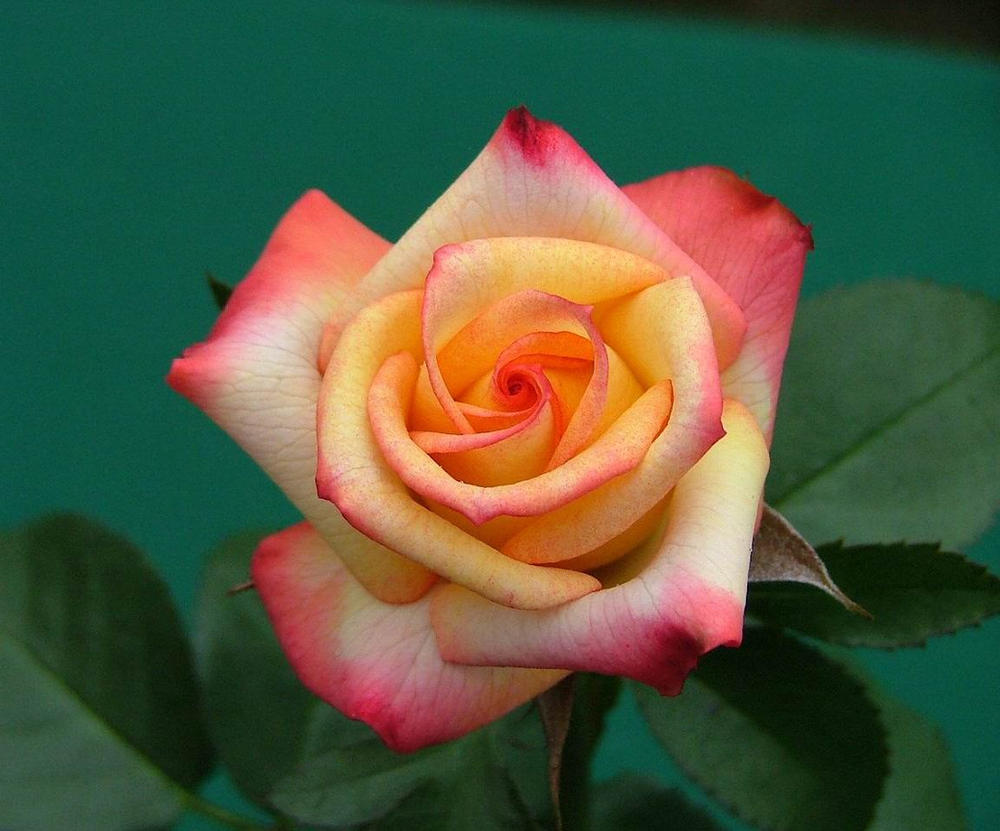
Solar Flair Queen shown by Suzanne Horn at OCRS Show, photo by Leslie Espagnol
My featured rose this month is an exceptional miniflora rose, ‘Solar Flair’, which is also one of my favorite roses in commerce. It is a hot, bi-color rose created by the late great hybridizer and exhibitor, Frank Benardella, and it serves as a fitting tribute to the hybridizing talents of this great rosarian. ‘Solar Flair’ was bred by Mr. Benardella in 2004, and was released in 2005 by a company called Nor’East Miniature Roses aka Greenheart Farms, which has since ceased to sell roses to the public.
This luscious miniflora (code name BENbaas) is a cross of Antique Gold x Brett’s Rose. It is a colorful yellow blend (yb) that has some of the best and most consistent form I’ve ever seen. For the exhibitors among us, this exciting miniflora has become a top show rose and is definitely a queen contender. It has already made its mark on trophy tables all over the country. In fact, ‘Solar Flair’ has been one of my favorite roses since I won the first Queen in the nation with it back in October of 2005.
The first bloom of ‘Solar Flair’ I ever entered in a show won Queen with a unanimous polling of the judges on the first round. I immediately went out and ordered ten more. See photos of my Miniature Queen of Show at the Orange County Rose Society Show along with the Miniature Royalty. All the roses were mine except the little one on the left (grin). Incidentally, the reason the rose won Miniature Queen and not Miniflora Queen was because at the time classes for miniflora roses had not yet been established. Therefore, rose shows combined miniatures and minifloras under the same category. It was largely due to the sheer excellence of the roses produced by Frank Benardella that the miniflora rose became as successful as it is today. The following is a little background on the magic man who brought the rose world so many fabulous introductions.

Born on July 5, 1932, Frank was a native of Millstone Township, New Jersey, where he lived with his lovely wife June. He was a robust man with a kind demeanor and a soft-spoken manner. He was known to be friendly to all he met, and he reminded me for all the world of the actor Christopher Walken. He was a Senior Vice President of International Sales for the Goody/Rubbermaid corporation, traveling around the world. Fun fact: Rubbermaid is a company which co-incidentally makes the brand of cool box that many rose exhibitors (including me) use to transport their miniature roses to shows. LEFT Frank & June Benardella, photo courtesy of Roseshow.com
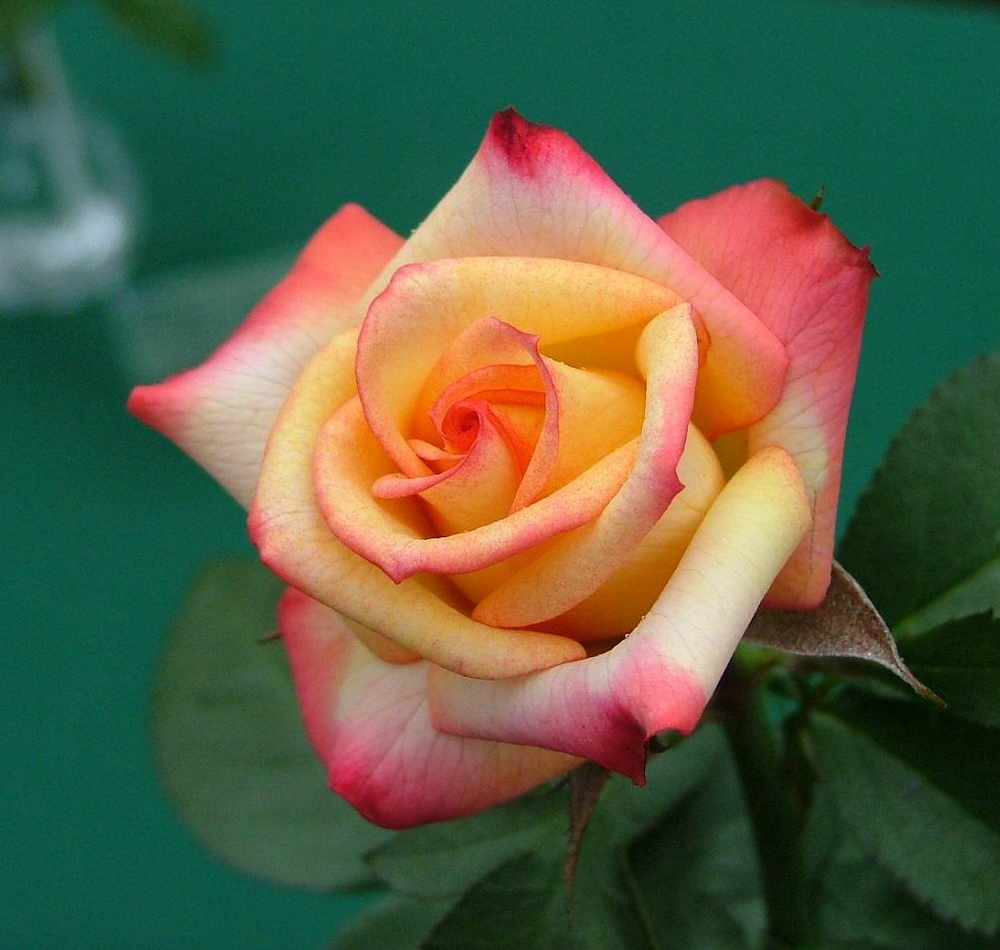
Frank developed an interest in roses in the 1950’s when, along with his wife June, he built a rose garden for her widowed mother. He subsequently built his first rose garden and after two years of growing roses, joined the American Rose Society. Frank then began growing and exhibiting roses; and it was a love affair that would last a lifetime. He garnered a wealth of knowledge about growing roses, and he willing passed on his wisdom to others. RIGHT: Solar Fair Queen shown by Suzanne Horn at OCRS Show, photo by Leslie Espagnol
As an exhibitor, Frank won most of the prestigious National Trophies. The trophy of which he was most proud was the Nicholson Bowl, a class that calls for nine matched hybrid tea roses. At that time his main interest was in regular sized roses. It wasn’t until years later that he became interested in miniatures. Exhibiting for Frank was a family affair, and he traveled to the major shows with June and the kids.
He quickly became an ARS judge and subsequently assisted in the writing of the ARS Judges Manual. He also became a Consulting Rosarian and won the Outstanding Consulting Rosarian Award in 1964. He joined his local Penn-Jersey District Rose Society and was elected District Director shortly thereafter. While he was District Director, Penn-Jersey hosted a special event celebrating 100 years of Sam McCredy’s Roses, attracting visitors from all over the world. Frank originated the first Mid-Winter Conventions during that period. These first conventions were held outside of rose show season. However, a fun fact I learned from the great U.K. rose exhibitor Ray Martin is that Frank encouraged enough members to grow roses under artificial lighting in their basement that they managed to stage rose shows at the conventions.
Frank was soon made Penn-Jersey Regional Director and subsequently President of the American Rose Society, a position in which he served from 1977 through 1979. He also became Vice President of the World Federation of Rose Societies, all the while remaining active in his home rose group, the Jersey Shore Rose Society. A little-known fact is that for years beginning in 1999, he pushed and encouraged Bob Martin to run for Vice President of the American Rose Society. That ultimately worked out very well, since Bob is our current President and has turned out to be exceptional in the position. In every way, even in his encouragement of others, Frank was a great champion of the rose.
I learned much about Frank’s background from Ray Martin. He advised that while Frank served as ARS President, “… amongst his many achievements he is credited with helping to develop the Palette class, instigating the ARS slide contest, developing the English box and printing the first miniature entry tags.” These are only some of the reasons that Martin documents Frank Benardella as Number One on his list of “rose heroes”.
Although he was a very successful exhibitor, Frank was unhappy with the selection of varieties available to him at the time. This sparked his interest in hybridizing. He initially focused on hybrid teas but was not impressed with the results of his crosses. A yellow Ralph Moore rose called ‘Rise ’n Shine’ became the starting point for his future successes.
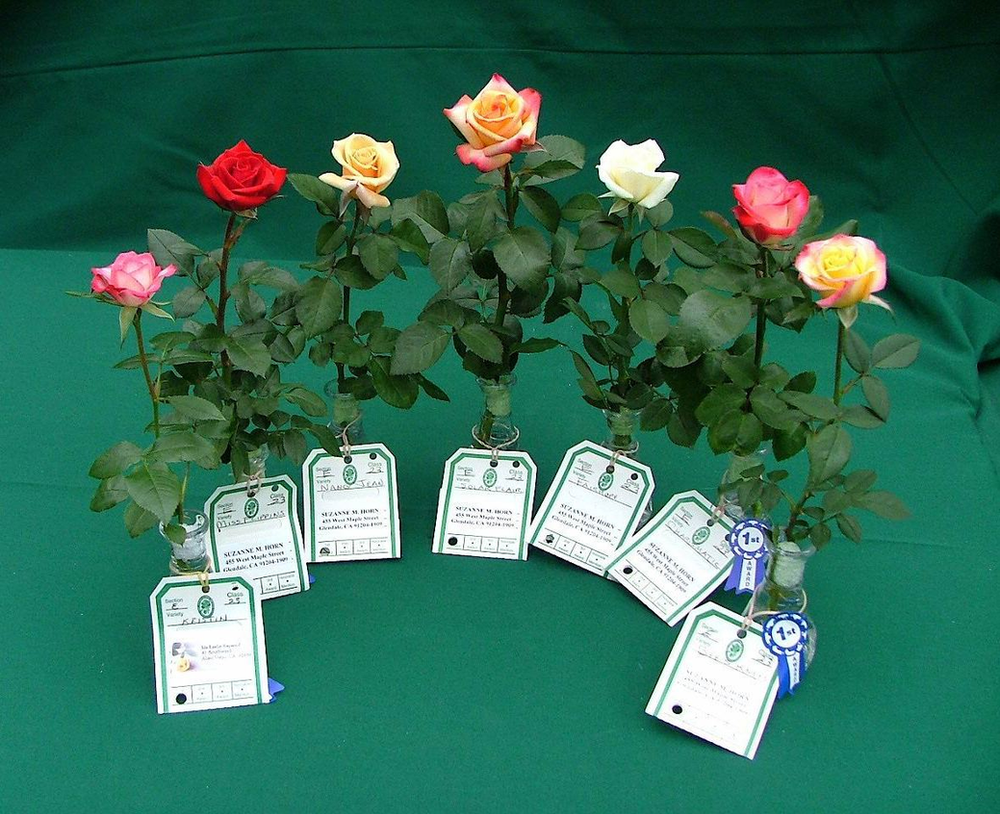
ABOVE: Solar Flair Queen amid royalty at OCRS Show, all but one rose shown by Suzanne Horn, photo by Leslie Espagnol
Frank’s first introduction hit the market in 1985, and Ray Martin shared an interesting story about how it almost didn’t. He wrote, “The rose was growing in Frank’s greenhouse when Sean McCann, a regular visitor to the Benardella household, spotted it and insisted that Frank should introduce it. The variety, Black Jade, is still probably the most popular miniature rose in its color class today.”
In 1993, Frank introduced what was to prove to be his favorite miniature rose, a seedling known as BENmagic. When his initial suggested name of Pure Wet was turned down by the ARS as being unsuitable, he named the rose after his newly born granddaughter, ‘Kristin’. In addition to becoming a wonderful exhibition miniature rose, ‘Kristin’ became an exceptional pollen parent. It was an aphorism of the day that the flowers of ‘Kristin’ held so well that they appeared to turn to potpourri on the bush.
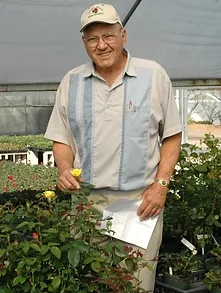
In 1994, Frank retired from his job at Rubbermaid in order to pursue his avocation of hybridizing roses. By that time, he had a number of roses from his breeding program in commerce. He continued to travel the world with June to rose growing hubs like Holland, Germany, Switzerland and South Africa. He gained acclaim for his hybridizing efforts in such areas as Japan, South Africa, Europe and New Zealand. RIGHT: Frank Benardella in Greenhouse, photographer unknown
Although Frank Benardella is mostly associated with miniature and miniflora roses, in 1995, he introduced a hybrid tea rose that was so commercially successful in the florist rose trade that it literally put him at the forefront of his hybridizing hobby. I learned from Ray Martin that “many of Frank’s roses are bred from crosses with his own seedlings and many of these seedlings owe their existence to crosses that Frank made with a collection of florist roses that he imported from Kordes in Germany.” To that end, Frank crossed the floribunda ‘Picasso’ with one of his own unnamed seedlings; and the resulting plant was a striped red blend hybrid tea he called ‘Zebra’.
Ray continues, “This was officially the first ‘bred’ striped HT. There are other striped HTs but they are sports. The floristry trade saw this new rose and loved it! Zebra was set to be Frank’s most successful rose. Over 1 million blooms were sold in the first year and royalties on the rose meant that the Benardella family would now move to Englishtown, New Jersey and Frank would be able to build for himself a state-of-the-art breeding house and more roses would soon be coming off the production line.”
Benardella became one of America’s most successful independent rose breeders, specializing in miniature and ultimately also miniflora roses that were as perfectly shaped as the classic hybrid tea rose, but on a smaller scale. These were roses that appealed to people with limited gardening space. Many of his roses would be tested in a variety of venues in a variety of countries before being introduced. He noted that the process of hybridizing roses is painstaking and often lengthy, with five to seven years, on average, between the first hand-pollinization or “cross” between parent roses and introduction of a marketable new rose.
A big part of the work of hybridizing is culling the less-promising seedlings. Frank noted in a matter-of-fact manner, “Ninety-nine percent of it is garbage.” Seedlings with two few petals, a lack of substance or a propensity for various rose diseases would be discarded.
In a story entitled “Earning His Stripes as a Hybridizer” in the 1994 American Rose Annual, exhibitor extraordinaire Frank Mattia wrote, “Benardella’s approach to creating Miniature roses involved making at least 50 crosses with the pollen from a parent plant, using a Hybrid Tea with excellent bloom form into a proven Miniature seed parent that readily sets hips. The crosses are made in the greenhouse over a four-month period between April and July. The Kordes cut flower ‘Laguna’, an orange-red Hybrid Tea, is one of his favorite pollen plants, since it readily passes on its desirable traits of good form and a panorama of pleasing bloom colors.”
Mattia continued, “Benardella, drawing on his background as an exhibitor, has achieved his hybridizing fame by consistently creating Miniature roses with classic Hybrid Tea form. It is the prime characteristic of nearly all his commercial successes. Indeed, the success of Benardella’s roses abroad revolves around the demand for picture-perfect Miniature roses for the cut flower trade.”
Frank was once quoted as saying, “I breed mostly for form. I want the flower to look pretty.” He certainly succeeded with that aim. In his later years, Frank was working on hybridizing a brown rose, something with hues of cocoa and coffee. When asked why, he answered, “Because it’s a challenge. Because it’s not there, at least not a brown rose without a lot of orange.”
Surprisingly to many, Frank was not initially a big fan of miniflora roses, although thankfully his attitude on the subject did evolve over time. He originally felt that minifloras were too big to be competitive at rose shows against the popular miniature roses. In discussions I had with Frank in years past, he advised me that he routinely discarded beautiful seedlings that he deemed too large to be introduced as miniature roses. It was not until the advent and subsequent popularity of the miniflora class that he began introducing some of those earlier seedlings that had not been discarded. The rose world is forever grateful that he did so.
Frank has been described as being “an icon in the World of Roses”. He certainly was to the international rose exhibiting community and to the countless number of rose lovers who grew his spectacular roses. In the years before he died, Frank was especially concerned about the future of roses based on recent trends and the “aging out” of dedicated rose growers. In recent years, rose sales have declined sharply and membership in the American Rose Society has also plunged to half its former size. While in the past national rose shows attracted 1,000 entries, Benardella noted, “now you’re lucky to get 300.”
Frank was once quoted as saying, “People don’t garden the way they once did, and now all you see going in the ground are those shrub roses sold as low-maintenance plants. To have beautiful roses, you do have to work at it a little. They need care, they need grooming. They need you.”
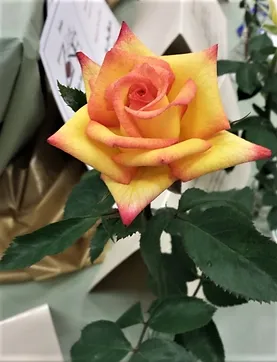
On a side note, hope springs eternal for the future of the American Rose Society, as it is now led by self-proclaimed rose evangelist Bob Martin. His knowledgeable and enthusiastic leadership is inspiring more interest and participation in rose societies, rose shows and exhibiting than ever before. In addition, there is the exuberance and dedication of Chris VanCleave from Alabama, the self-proclaimed “Redneck Rosarian” and head of Membership for the ARS, who is also spreading the love of roses nationwide. LEFT: Solar Flair MF Court, shown by Suzanne Horn at Desert Rose Society Show, photo by Suzanne Horn
We lost Frank Benardella to cancer on January 30, 2010 at the age of 77. However, he has left behind a magnificent body of work for the rose lovers of the world to remember him by. His legacy includes having had a number of roses admitted into the Miniature and Miniflora Rose Hall of Fame including ‘Black Jade’, admitted in 2006, and ‘Kristin’, elected in 2011. This honor is reserved for roses that have proven their worth over time and remained in commerce for more than 20 years.
At least 18 of his miniature and miniflora introductions received the coveted AOE (Award of Excellence) accolade. For those readers not familiar with this program, in 1973 the American Rose Society Board of Directors established the Award of Excellence to recognize new miniature and miniflora rose varieties of superior quality and marked distinction. Award of Excellence winners are chosen only after a two-year trial in nine public test gardens nationwide. The trials gauge how well roses do in a variety of American climates.
Frank noted, “You need to get them out there. I grow roses in the greenhouse and they look like one thing. Outside, they can look like something else.” Outside, the seedlings could prove to be meager bloomers or susceptible to diseases like powdery mildew or blackspot.
Benardella’s Miniature AOE award winners included the medium pink ‘Baby Boomer’ (2003), the dark red ‘Black Jade’ (1985), the red blend ‘Bonfire’ (2006), the dark red ‘Caliente’ (2005), the light pink ‘Figurine’ (1991), the pink blend ‘Jennifer (1985), the red blend ‘Jim Dandy’ (1989), the red blend ‘Kristin’ (1992), the red blend ‘Magic Show’ (2009), the red blend ‘Merlot’ (2001), the medium red ‘Old Glory’ (1988), the red blend ‘Picotee’ (2003), the dark red ‘Ruby’.
His Miniflora AOE winners included the apricot ‘Ambiance’ (2008), the mauve ‘Deja Bleu’ (2008), the white ‘Leading Lady’ (2006), the medium red ‘Power Point’ (2008), and the apricot ‘Show Stopper’ (2007). Additional outstanding miniature roses he introduced included the recently released dark yellow ‘Bob Martin’ (2018), the red blend ‘Hilde’ (1999), the medium pink ‘Jilly Jewel’ (2003), the orange-red climbing miniature ‘Radiant’ (1988), the pink blend ‘Rosie’ (1987), and the pink blend ‘Soroptimist International’ (1995). Additional exceptional miniflora roses he introduced included the red blend ‘Double Take’ (2008), the medium pink ‘Flawless’ (2008), the pink blend ‘Focal Point’ (2008), the red blend ‘Liberty Bell’ (2003), and our featured yellow blend rose in this article, ‘Solar Flair’ (2004).
Although Frank specialized in hybridizing miniature and miniflora roses, he did dabble in creating larger roses like the red blend floribunda ‘Pinnacle’, the red blend hybrid tea ‘Zebra’ and the white climbing hybrid tea ‘Pele’. Kitty Belendez later discovered an orange sport on ‘Pinnacle’, which she named ‘Cristina Lynne’.
I may have missed a few of Frank’s stellar creations on my list, since he was so prolific in his hybridizing. Frank himself eventually lost track of exactly how many new roses he introduced worldwide, but no fewer than 35 are available in U.S. markets. And more keep coming. Some good news is that many of his seedlings that were not introduced during his lifetime are now being named and introduced by Richard Anthony at ‘For Love of Roses’. In addition, amateur hybridizer Suni Bolar inherited a greenhouse full of Frank’s seedlings from June Benardella at the time of Frank’s passing; and she has utilized those seedlings into her own breeding program. As such, we will be blessed to be able to enjoy more of Frank’s work being introduced to the public in the future.
As for ‘Solar Flair’, this gorgeous miniflora rose literally speaks excellence to you. The blooms are absolutely stunning, presenting exquisite exhibition form, complete with high centered, hybrid tea shaped blooms. Beautiful, pointed ovoid buds unfurl to reveal perfectly spiraled blooms with pinpoint centers set upon long straight stems. Those impeccably formed blossoms come mostly as one bloom per stem, although the occasional spray will present itself. The petals are quilled and are reminiscent of Glowing Amber and Amber Star, which are full of substance year-round.
Its most notable feature is, of course, its eye-catching, almost electric hue, a dazzling golden yellow with bright red edging. It will stop you in your tracks in the garden with its stunning color blend, and it will be the one to draw your focus across a showroom filled with hundreds of other roses. Furthermore, the medium green, semi-glossy foliage sets a complimentary frame for the stunning red-gold blooms.
As far as growth habit goes, the plant is quite robust, and the blooms are full-figured, measuring up to two inches or more across when fully open and presenting 27 to 35 petals. It is medium tall, growing from 24 inches to about 36 inches, and grows in an upright manner, which makes it excellent for growing in containers.
This spectacular miniflora is not totally disease resistant, but it is not a mildew magnet either. It does its best here in the Pacific Southwest if it is sprayed on a regular basis. A good and diligent spray program along with occasional morning showers to the foliage will keep it looking clean and beautiful throughout the year.
To summarize, ‘Solar Flair’ continues to be one of the best miniflora roses I’ve had the privilege to grow, a showstopper both in the garden and on the trophy table. It is currently available from For Love of Roses (www.forloveofroses.com) as part of their collection of miniature and miniflora miniature offerings for sale. Along with so many of his other magnificent introductions, ‘Solar Flair’ carries on the legacy of the late, great Frank Benardella. Through his roses and the memories of those of us who knew him, he will never be forgotten.




























































